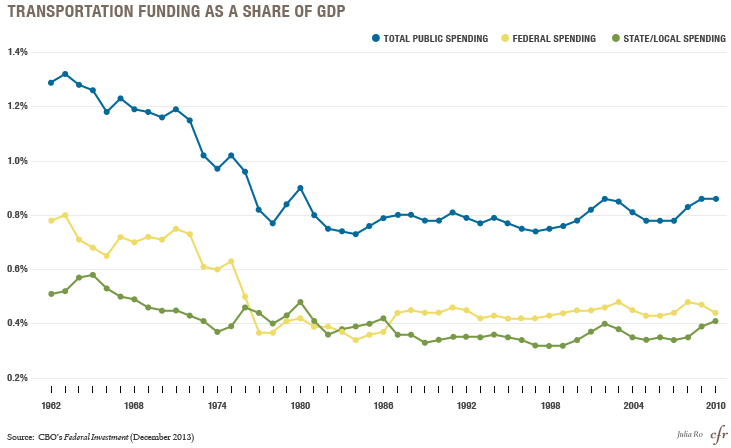COUNCIL ON FOREIGN RELATIONS
Written by Steven J. Markovich, Contributing Editor
Introduction
Infrastructure is critical to economic growth, but the aging U.S. transportation system suffers from insufficient investment. As this CFR Progress Report and Scorecard, Road to Nowhere, explains, other nations are building new highways as the United States’ crumble. U.S. transportation fell from fifth in the World Economic Forum’s rankings in 2002 to twenty-fourth in 2011, passed by nations such as Spain, South Korea, and Oman. Making a U-turn will take some time since major infrastructure projects require several years to plan and execute.
The decline can be attributed to a general trend of under-investment in infrastructure; the American Society of Civil Engineers (ASCE) has only awarded overall grades of D or D+ to U.S. infrastructure in all five report cards issued from 1998 to 2013. Current infrastructure requires more investment—for instance, one in nine U.S. bridges are structurally deficient—while new projects are needed to address issues such as road congestion, which costs American drivers $101 billion annually in wasted time and fuel, and airport delays that are a $22 billion drag on the economy.
While experts have been warning about crumbling infrastructure for more than a decade, the federal government has not addressed underinvestment. The Obama administration has attempted to prioritize transportation infrastructure by making it the second largest component of the 2009 Recovery Act, and proposing the GROW AMERICA Act to provide four years of comprehensive funding to modernize highways, railways, and mass transit. But the former was a temporary measure and the latter is unlikely to gain traction in Congress. Aside from the Recovery Act and a two-year reauthorization plan passed in 2012, Congress has only passed short-term reauthorizations to keep the Highway Trust Fund afloat.
Investing for Tomorrow
U.S. transportation infrastructure requires substantial capital investment because many of the highways and bridges built decades earlier are now reaching the end of their expected lifespan. For the last few decades, the nation has benefited from investments from the Eisenhower era through the 1980s. From the 1980s onward, transportation infrastructure spending as a share of U.S. GDP stagnated.
View Original Version (CFR.org) – Transportation Infrastructure: Moving America
About the Council on Foreign Relations
cfr.org
The Council on Foreign Relations (CFR) is an independent, nonpartisan membership organization, think tank, and publisher dedicated to being a resource for its members, government officials, business executives, journalists, educators and students, civicand religious leaders, and other interested citizens in order to help them better understand the world and the foreign policy choices facing the United States and other countries.
From CFR.org. Reprinted with permission. For more analysis on infrastructure and foreign policy, visit CFR.org.
Tags: American Society of Civil Engineers, ASCE, CFR, Council on Foreign Relations, Recovery Act, Steven J. Markovich







 RSS Feed
RSS Feed
Spending on what? Just repair and maintenance or investments in systems that are likely to have lower costs and higher performance than roads, rail transit and buses (conventional modes). Why is most of the work on innovative systems underway outside of the US (Japan, China, S. Korea, U.K., Netherlands, Sweden and so on.
Examples of “better ways” to spend transport dollars are abundant but all present focus appears to be on extending conventional modes. For instance: http://www.tts-21.com from China. http://www.tevproject.com from the U.K. Lots of other systems are described and illustrated at the Innovative Transportation Technologies website at http://faculty.washington.edu/jbs/itrans Smart spending is required to address urban transport problems which are now our most critical. Long range transport plans are available in most metropolitan area – but all the include are repair, maintenance and extensions of conventional technologies, many of which are not cost-effective and inappropriate for matching up with our dispersed and dispersing urban regions.